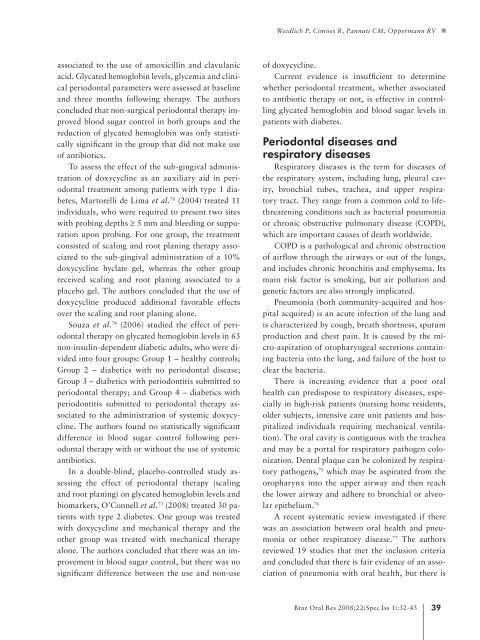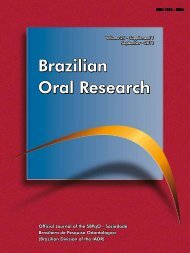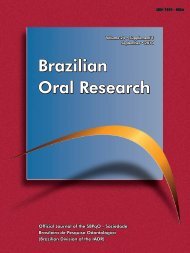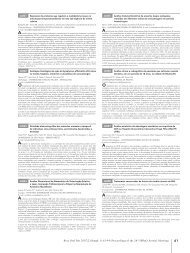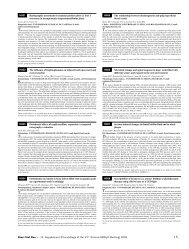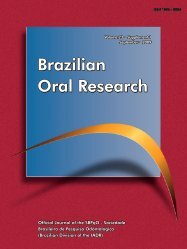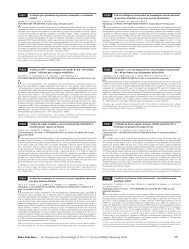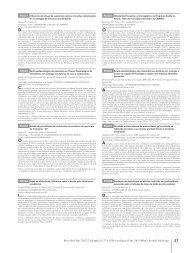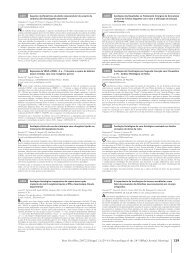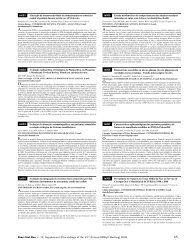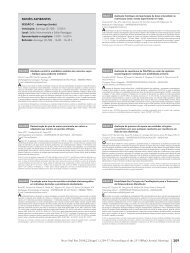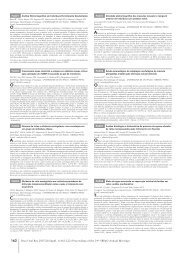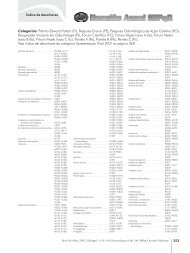Brazilian Oral Research Brazilian Oral Research Brazilian Oral
Brazilian Oral Research Brazilian Oral Research Brazilian Oral
Brazilian Oral Research Brazilian Oral Research Brazilian Oral
Create successful ePaper yourself
Turn your PDF publications into a flip-book with our unique Google optimized e-Paper software.
associated to the use of amoxicillin and clavulanic<br />
acid. Glycated hemoglobin levels, glycemia and clinical<br />
periodontal parameters were assessed at baseline<br />
and three months following therapy. The authors<br />
concluded that non-surgical periodontal therapy improved<br />
blood sugar control in both groups and the<br />
reduction of glycated hemoglobin was only statistically<br />
significant in the group that did not make use<br />
of antibiotics.<br />
To assess the effect of the sub-gingival administration<br />
of doxycycline as an auxiliary aid in periodontal<br />
treatment among patients with type 1 diabetes,<br />
Martorelli de Lima et al. 70 (2004) treated 11<br />
individuals, who were required to present two sites<br />
with probing depths ≥ 5 mm and bleeding or suppuration<br />
upon probing. For one group, the treatment<br />
consisted of scaling and root planing therapy associated<br />
to the sub-gingival administration of a 10%<br />
doxycycline hyclate gel, whereas the other group<br />
received scaling and root planing associated to a<br />
placebo gel. The authors concluded that the use of<br />
doxycycline produced additional favorable effects<br />
over the scaling and root planing alone.<br />
Souza et al. 74 (2006) studied the effect of periodontal<br />
therapy on glycated hemoglobin levels in 63<br />
non-insulin-dependent diabetic adults, who were divided<br />
into four groups: Group 1 – healthy controls;<br />
Group 2 – diabetics with no periodontal disease;<br />
Group 3 – diabetics with periodontitis submitted to<br />
periodontal therapy; and Group 4 – diabetics with<br />
periodontitis submitted to periodontal therapy associated<br />
to the administration of systemic doxycycline.<br />
The authors found no statistically significant<br />
difference in blood sugar control following periodontal<br />
therapy with or without the use of systemic<br />
antibiotics.<br />
In a double-blind, placebo-controlled study assessing<br />
the effect of periodontal therapy (scaling<br />
and root planing) on glycated hemoglobin levels and<br />
biomarkers, O’Connell et al. 73 (2008) treated 30 patients<br />
with type 2 diabetes. One group was treated<br />
with doxycycline and mechanical therapy and the<br />
other group was treated with mechanical therapy<br />
alone. The authors concluded that there was an improvement<br />
in blood sugar control, but there was no<br />
significant difference between the use and non-use<br />
Weidlich P, Cimões R, Pannuti CM, Oppermann RV<br />
of doxycycline.<br />
Current evidence is insufficient to determine<br />
whether periodontal treatment, whether associated<br />
to antibiotic therapy or not, is effective in controlling<br />
glycated hemoglobin and blood sugar levels in<br />
patients with diabetes.<br />
Periodontal diseases and<br />
respiratory diseases<br />
Respiratory diseases is the term for diseases of<br />
the respiratory system, including lung, pleural cavity,<br />
bronchial tubes, trachea, and upper respiratory<br />
tract. They range from a common cold to lifethreatening<br />
conditions such as bacterial pneumonia<br />
or chronic obstructive pulmonary disease (COPD),<br />
which are important causes of death worldwide.<br />
COPD is a pathological and chronic obstruction<br />
of airflow through the airways or out of the lungs,<br />
and includes chronic bronchitis and emphysema. Its<br />
main risk factor is smoking, but air pollution and<br />
genetic factors are also strongly implicated.<br />
Pneumonia (both community-acquired and hospital<br />
acquired) is an acute infection of the lung and<br />
is characterized by cough, breath shortness, sputum<br />
production and chest pain. It is caused by the micro-aspiration<br />
of oropharyngeal secretions containing<br />
bacteria into the lung, and failure of the host to<br />
clear the bacteria.<br />
There is increasing evidence that a poor oral<br />
health can predispose to respiratory diseases, especially<br />
in high-risk patients (nursing home residents,<br />
older subjects, intensive care unit patients and hospitalized<br />
individuals requiring mechanical ventilation).<br />
The oral cavity is contiguous with the trachea<br />
and may be a portal for respiratory pathogen colonization.<br />
Dental plaque can be colonized by respiratory<br />
pathogens, 75 which may be aspirated from the<br />
oropharynx into the upper airway and then reach<br />
the lower airway and adhere to bronchial or alveolar<br />
epithelium. 76<br />
A recent systematic review investigated if there<br />
was an association between oral health and pneumonia<br />
or other respiratory disease. 77 The authors<br />
reviewed 19 studies that met the inclusion criteria<br />
and concluded that there is fair evidence of an association<br />
of pneumonia with oral health, but there is<br />
Braz <strong>Oral</strong> Res 2008;22(Spec Iss 1):32-43


